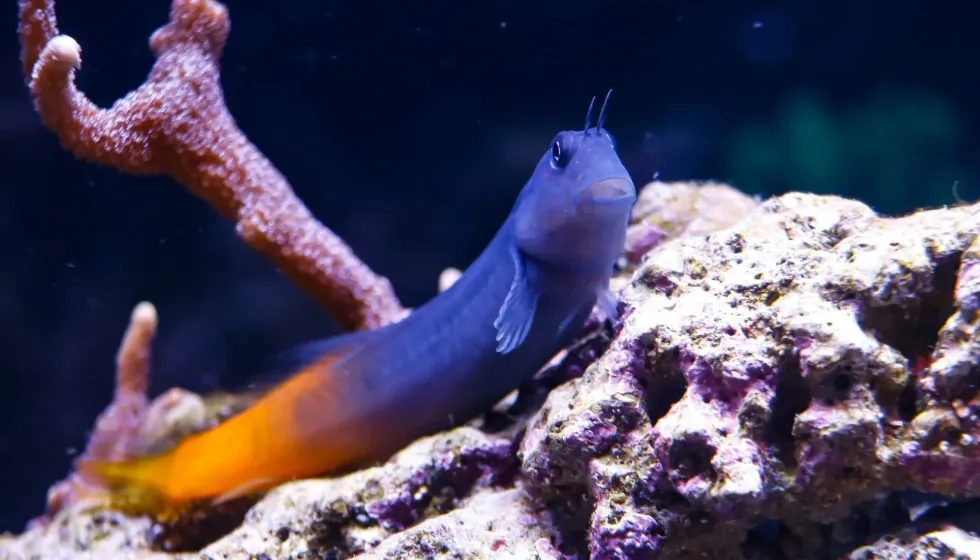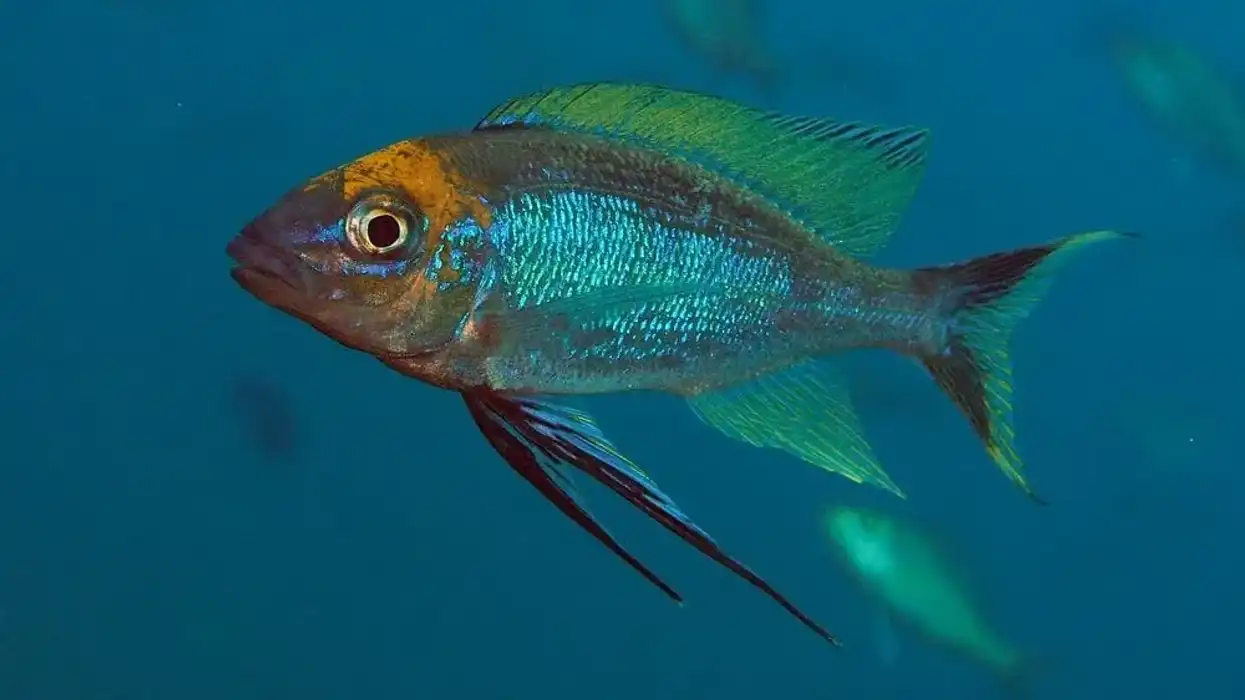Bicolor blenny (Ecsenius bicolor) is a two-colored herbivore fish species, commonly found around crevices and rocks on the bottom of its surroundings. This fish species is also called two-colored benny, owing to its half blue and half orange color. Ecsenius bicolor blennies are reef safe and display excellent personality in reef aquariums.
Bicolor blennies need a minimum tank size of 30 gal (115 L) along with living rocks and different rocks spread around for the purpose of hiding and perching. In aquariums, you need to feed bicolor blennies frozen foods, shrimp, and algae based marine meals and foods.
The diet of this fish species largely includes vegetable matter, shrimp, and algae foods.
This Ecsenius bicolor fish species is generally believed to have a peaceful temperament. At times, blenny the bicolor can get aggressive with gobies, dartfish, corals, and other blennies in the tank.
You need to be cautious when bicolor blennies are set up in smaller tanks with fleshy corals and clams when underfed. As far as large reef aquariums are concerned, there is nothing to worry about owing to the peaceful temperament of this fish species.
If you like this article on blenny the bicolor facts, you might also be interested to read Midas blenny and starry blenny facts.
Bicolor Blenny Interesting Facts
What type of animal is a bicolor blenny?
The bicolor blenny (Ecsenius bicolor) is a type of fish species belonging to the family of Blennidae. It is a saltwater aquarium fish and its native place of origin is the Indo-Pacific.
What class of animal does a bicolor blenny belong to?
The bicolor blenny is a type of reef safe fish species belonging to the Animalia kingdom and Actinopterygii class.
How many bicolor blennies are there in the world?
Bicolor blennies are found in abundance in the Indo-Pacific region, which also happens to be its native origin place.
Where does a bicolor blenny live?
Blennies are bottom dwelling marine fishes and live in shallow water in the ocean. As a popular saltwater aquarium fish, blennies can be found in reef aquariums too.
What is a bicolor blenny’s habitat?
The native habitat of blenny the bicolor is the Indo-Pacific. This marine fish species is most commonly found in tropical and cold seas. Common habitats of blennies include reefs, beds of kelp, sandy beaches, and rocky pools.
Who do bicolor blennies live with?
Larger aquariums make sure that blenny ecsenius bicolor fish get enough live rock space of their own in tanks, owing to their territorial nature. Keeping two blennies together in smaller aquariums is not a great idea.
When kept together in smaller aquariums, blennies display an aggressive temperament and tend to pick fights with other marine fish. This is more likely when you keep blenny ecsenius bicolor fish with little fish species that resemble their own appearance such as gobies in one aquarium tank.
Both gobies and bicolor blenny ecsenius are found in the Indo-Pacific. Owing to their similar size, shape, and looks, blennies are often mistaken as gobies and vice-versa. When it comes to anatomy and behavior, gobies and bicolor blenny ecsenius are quite different from each other.
Unlike bicolor blenny ecsenius, gobies have a suction cup that helps them attach to rocks and shells. This suction cup is made by fused pelvic fins.
Blenny ecsenius bicolor on the other hand stand out by having a hair like growth above their eyes. This hair like growth resembling algae is known as cirri. Apart from this, most blennies have subdued colors, whereas, gobies are brightly colored.
How long does a bicolor blenny live?
On average, a bicolor blenny ecsenius can live for two to four years. A bicolor blenny ecsenius can also live for 10 years in captivity.
How do they reproduce?
Bicolor blennies are nesters and egg guarders. For breeding, females lay eggs in crevices and continue to guard them until they are hatched.
What is their conservation status?
The bicolor benny (Ecsenius bicolor) is categorized as a Least Concern species, meaning that these marine fish are still being bred in different parts of the world and have a stable population.
Bicolor Blenny Fun Facts
What does the bicolor blenny look like?
Blenny the bicolor is a dual color small and slim marine fish. Blennies are moderately elongated and have long pelvic and dorsal fins.
The bicolor blenny has a blue anterior and a yellow to bright orange posterior. Male blennies are larger than female blennies, with an extended first dorsal fin. The orange color of some blennies varies from yellow to brown in color.
How cute are they?
One of the most fascinating facts about blenny bicolor is that many of them like to indulge in mimicry. You can often find blennies in aquariums copying other little fish in tanks.
By mimicking other fish, blennies get a chance to become closer with them in the aquarium tank. Clever blennies use this as a strategy to pass close by other fish in the aquarium. While doing so, these cute blennies might also bite the other fish in the aquarium tank.
How do they communicate?
Not much is discovered about how bicolor blennies communicate.
How big is a bicolor blenny?
A blenny bicolor can grow up to 4 in (11 cm) in length, needing a minimum tank size of 30 gal (115 L). A male bicolor blenny is larger in size than a female blenny.
How fast can a bicolor blenny swim?
Blennies are not active swimmers like other little fish in aquariums. Instead, they like to hop from one rock to another rock, pick meals, and swim to the next rock in the aquarium tank. However, blennies are quite inquisitive and must not be mistaken to be lazy swimmers.
How much does a bicolor blenny weigh?
A bicolor blenny generally weighs around 11 lb (4.9 kg).
What are the male and female names of the species?
There are no separate names for males and females of the bicolor blenny fish species. However, both the males and females counterparts of this fish are commonly known by many other names such as two colored blennies, ecsenius bicolor, flame tail blenny, and blenny the bicolor.
What would you call a baby bicolor blenny?
A baby bicolor blenny does not have a separate name.
What do they eat?
The diet and meals of a bicolor blenny include dead plants, algae, shrimp and animal matter. Most species of blennies have an herbivore diet and some have a full to partially carnivore diet.
Other foods you must feed blennies include frozen, dried meals like frozen shrimp, mysis shrimp and algae based meals. You can also feed flake foods to bicolor blenny.
Are they dangerous?
A blenny's temperament is peaceful. However, despite their small size and appearance, blenny bicolor males and females can become aggressive. This is mainly because of their territorial temperament.
Not all blennies display an aggressive temperament or are dangerous. A lot of blennies also have calm, peaceful, and composed personalities. The benny bicolor’s personality usually become aggressive in smaller tanks in aquariums, especially when they are put together with other little fish like gobies and mantles of clams.
Would they make a good pet?
Ecsenius bicolor is believed to be an intelligent and clever fish species. This species has an easy care level in the aquarium. Some blennies also display comical mannerisms, making them a fun fish personality to have around in reef tank aquariums.
The bicolor blenny is quite curious to know what’s happening around them in the aquarium tank. This is why you will usually find them hopping from one live rock to another rock in an aquarium tank. They also like hiding between rocks, feeding in the reef aquarium tank.
There is no doubt about the fact that the bicolor blenny makes for an interesting pet in reef tank aquariums. The bicolor blenny needs a minimum tank size of 30 gal (115 L). Reef aquarium tanks should have enough dwell rocks as blennies are extremely fond of hiding and perching.
The height of the reef aquarium tank should be safe enough to keep the bicolor blenny from jumping out of the water, owing to their famous jumping habits.
Did you know…
Sometimes, bicolor blenny will jump out of fish tanks in reef aquariums. Blennies love to hop from one rock to another and at times even jump out of reef aquarium tanks.
This is why you must use a tight lid to shut your aquarium tank and prevent your bicolor blennies from jumping out.
Sometimes, blennies might also want to jump out of the aquarium tank due to an imbalanced PH level, optimum ph 8.1-8.4, in water or ammonia concentration. Make sure your aquarium tank water is regularly cleaned to maintain the oxygen supply for your blennies to stay in and be safe.
Are bicolor blennies reef safe?
Bicolor blennies are reef safe with an easy care level. However, blennies are known to pick at other blennies, gobies, dartfish, fleshy corals, the mantles of clams, and corals when underfed in small setups in the aquarium.
Do bicolor blennies eat algae?
Yes, the blenny the bicolor likes to feed on algae in between other meals. Blennies also enjoy feeding on marine algae. Their diet and meals also include seaweed and other algae based foods two to three times a day.
Here at Kidadl, we have carefully created lots of interesting family friendly animal facts for everyone to discover! Learn more about some other fishes from our manta ray facts and Teira batfish facts pages.
You can even occupy yourself at home by coloring in one of our bicolor blenny coloring pages.









